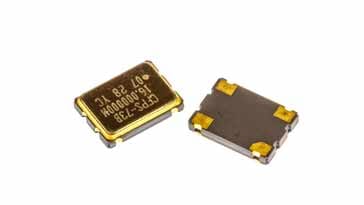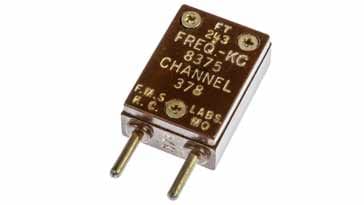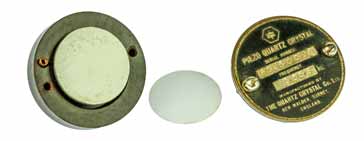Quartz Crystal Resonator Timeline & History
From the early observations about quartz and its peizo-effect, it has taken many years for quartz crystal resonators to be developed to where they are now.
Quartz Crystal History Includes:
Quartz crystal timeline / history
Vintage crystal types
It is sometimes interesting to look at how the quartz crystal was developed and some of the significant dates within its timeline. From the earliest discoveries at the beginnings of electrical and electronic history through to the current days.
Early quartz crystal resonator units were large and bulky, but today’s quartz crystal resonators are very much smaller. They are contained in hermetically sealed cans and they can even be obtained in surface mount packages.
The styles for quartz crystals have changed and their performance has significantly improved in virtually all aspects over the years.

Quartz crystal resonators
Quartz crystals utilise the piezo-electric effect to link the electrical domain with the very high Q resonances of the quartz crystal itself.
Using these crystals enables particularly high performance resonators to be manufactured and today the cost of these crystals can be very low considering their performance. Obviously high tolerance crystals are available at a higher price but many low cost ones are used in many areas of electronics design and manufacture.
These crystals are used in a wide variety of areas from the resonant element in clock oscillators in microprocessor boards, PCs etc, to crystal oscillators for RF design, as well as in voltage controlled crystal oscillators VCXOs, temperature compensated crystal oscillators TCXOs and also very high performance oven controlled crystal oscillators OCXOs.

In view of their widespread and common usage, it is interesting to see how these components developed over the years.
Note on Quartz crystal resonators:
Quartz crystals have become an essential part of today's electronics providing a high performance resonator at low cost. These components are used as the resonant element in many electronic designs from microprocessor clock oscillators to RF designs for oscillators to high performance stable oscillators and also within crystal filters.
Read more about Quartz crystal resonator technology.
Quartz crystal resonator timeline
The table below gives some of the major milestones in the timeline of the history of quartz crystal use in radio and electronic circuit designs.
Over the years, the use of quartz crystal resonators in electronic designs has grown rapidly. From their early uses mainly in RF design, they have become more widely used in other fields of electronics as well.
| Quartz Crystal Resonator Timeline & History:- Key Dates |
|
|---|---|
| Year | Timeline Details |
| Ancient Greek times | Quartz has been known about and attracted attention of many peoples from the earliest times; water-clear crystals of quartz were known to the ancient Greeks as krystallos. |
| 1530 | The name quartz is an old German word. Its origin is uncertain but it appears to have been used first by Georgius Agricola around this time. |
| 1880 | Jacques and Pierre Curie notice and investigate the piezo-electric effect in quartz. |
| 1893 | Lord Kelvin further investigates piezoelectric effect in quartz crystals and develops a value for the piezo-electric constant. |
| 1917 | Oscillator is developed by Alexander Nicholson of Bell Laboratories using Rochelle Salt and patents the idea in 1918. |
| 1918 | Paul Langevin investigates the use of plates cut from quartz crystals to develop early sonar system for detecting submarines. System was not perfected until after 1918. For this work, Langevin used X-cut plates of quartz to generate and then detect the sound waves in water. |
| 1918 - 1921 | Both A W Nicholson of bell Labourites and Professor W G Cady of The Wesleyan University study piezo electric oscillators. |
| 1921 | Prof. W. G. Cady at Wesleyan University patented a quartz crystal oscillator. For this patent, he used a quartz crystal resonator to control the frequency of an oscillator he also described the use of quartz bars and plates as frequency standards and wave filters. It is generally accepted that Cady was the first to use a quartz crystal to control the frequency of an oscillator circuit. |
| 1923 | Harvard professor, G W Pierce develops a crystal oscillator circuit which places the crystal between the grid and anode of the valve / vacuum tube. This is a predecessor to the Pierce oscillator configuration. |
| 1925 | Westinghouse installed a crystal oscillator for the master oscillator of their broadcast station KDKA. |
| 1925 | An equivalent circuit for the quartz crystal resonator is developed by Van Dyke. |
| 1926 | Many other broadcast stations use crystal controlled oscillators for controlling their signal frequency. As channel assignments start to become closer as more stations begin broadcasting, the need for closer frequency control becomes important. |
| 1926 | Y cut crystal first discovered and used. Up until this time, X cut quartz crystals had been the only form used. It was discovered that although the X cut crystal has a temperature coefficient of around -20ppm/°C and the Y cut crystal exhibits a temperature coefficient of around +100ppm/°C, it showed how different cuts might exhibit different temperature coefficients. |
| Around 1926 | Amateur radio experimenters start to use quartz crystals for the master oscillators in their transmitters. These oscillators enabled a higher output to be obtained from the oscillator when compared to an LC tuned oscillator meaning that fewer valves / tubes were required in their designs. With costs associated with valves / tubes at the time being high, this was a major consideration. Quartz crystals also gave a much more stable signal. |
| 1927 | First quartz crystal oscillator standard developed by Warren Marrison of Bell Laboratories. |
| 1934 | The AT and BT cuts for quartz crystal resonators were first seen. These cuts were discovered independently by Lack, Willard and Fair in the USA, Koga in Japan, and Bechmann and Straubel in Germany.. |

| 1950 | A hydrothermal process for growing quartz crystals on a commercial scale was developed at Bell Laboratories. |
| 1956 | Synthetically grown quartz becomes widely available. |
| 1968 | Juergen Staudte of North American Aviation invented a photolithographic process for manufacturing quartz crystal oscillators. This allowed them to be made small enough for portable products like watches. |
| 1974 | SC cut quartz crystal theorised by R Holland. The concept was not realised at this stage but just proposed in theory. |
| 1976 | First SC cut crystals become available. They are used mainly for oven controlled crystal oscillators as they have their optimum temperature coefficient at a temperature where these oven controlled oscillators operate. |
Construction of early quartz crystal resonators
Modern quartz crystals now use highly sophisticated manufacturing techniques. In some areas they have similarities to semiconductor fabrication. Both use techniques like chemical etching to obtain the highest accuracy.
Today, modern quartz crystals are contained in hermetically sealed packages to ensure the lowest levels of ageing.
However, this has not always been the case, and early quartz crystals were held between two sprung loaded plates which were not greatly sealed in any way.

With the older quartz crystal units, it was possible to disassemble them by simply undoing a few screws. Although they may have been protected from major dust and other items, they were no sealed from the atmosphere and as a result specifications like ageing would not have been nearly as good as modern day crystal resonators.
It was even possible to take them out of their holders and handle them. Although they could be cleaned with an organic solvent, this would still result in chemicals entering the crystal lattice and causing frequency changes.
Adjusting the frequency of some older crystal resonators
However, one advantage was that it was possible to "tweak" the frequency. It was found that a small pencil lead (graphite) mark on the crystal would lower its frequency slightly.
Although quartz crystal resonator technology does not have the investment of other electronics related technologies like silicon and integrated circuits, it nevertheless plays a very important role in the electronics industry. Developments continue to be made and additional dates will be added to the timeline as history moves on.
 Written by Ian Poole .
Written by Ian Poole .
Experienced electronics engineer and author.
More History:
Radio history timeline
History of the radio
Ham radio history
Coherer
Crystal radio
Magnetic detector
Spark transmitter
Morse telegraph
Valve / tube history
PN junction diode invention
Transistor
Integrated circuit
Quartz crystals
Classic radios
Mobile telecoms history
Vintage mobile phones
Return to History menu . . .




